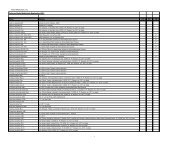Cordyceps - Aloha Medicinals Inc.
Cordyceps - Aloha Medicinals Inc.
Cordyceps - Aloha Medicinals Inc.
Create successful ePaper yourself
Turn your PDF publications into a flip-book with our unique Google optimized e-Paper software.
6 <strong>Cordyceps</strong><br />
most of the subjects treated with C. sinensis reported a<br />
significant clinical improvement in the areas of fatigue,<br />
cold intolerance, dizziness, frequent nocturia, tinnitus,<br />
hypo sexuality, and amnesia, while no improvement<br />
was reported in the placebo group. [1,7,16–18] Another<br />
study involving healthy elderly volunteers, with an average<br />
age of 65, tested the output performance and oxygen<br />
capacity of subjects while exercising on stationary<br />
bicycles. A portion of the volunteers consumed C.<br />
sinensis for six weeks, while others consumed a placebo.<br />
The results demonstrated that the group that consumed<br />
<strong>Cordyceps</strong> had a significant increase in energy output<br />
and oxygen capacity over the other group after six<br />
weeks. [47]<br />
Among the simplest and most reliable tests used to<br />
determine a compound’s ability to increase the energy<br />
output of a subject or decrease fatigue is the mouse<br />
swim test. In this test, two groups of mice (or other<br />
animals) are used. One group receives a standard diet,<br />
while the other receives the same diet with the addition<br />
of the test compound. In this case, the test compound<br />
is <strong>Cordyceps</strong>. After a period of time, the two groups<br />
are put into a steep-sided container filled with water,<br />
from which escape is not possible. In this way, the<br />
animals are forced to swim. The time-to-exhaustion is<br />
measured for each group, which was compared and<br />
contrasted with that of the other. If the group receiving<br />
the test compound swims longer than the group on the<br />
standard diet without the test compound, then it has<br />
been determined that they had increased energy output=decreased<br />
fatigue when compared with the control<br />
group. Trials of this nature have been conducted using<br />
<strong>Cordyceps</strong> as the test compound and have invariably<br />
shown that the use of <strong>Cordyceps</strong> significantly increases<br />
the time-to-exhaustion in laboratory animals when<br />
compared with the control groups. [7]<br />
PRECLINICAL AND CLINICAL DATA<br />
Therapeutic applications of <strong>Cordyceps</strong> and its extracts<br />
are hypothesized to be centered primarily on the key<br />
effects of increased oxygen utilization, increased ATP<br />
production, and the stabilization of blood sugar metabolism.<br />
[12] The presence of Adenosine, Cordycepin,<br />
and Cordycepic acid [D-Mannitol] (Chen and Chu [6] ),<br />
polysaccharides, vitamins, and trace elements may be,<br />
at least partially, the cause for such effects. Because<br />
of the historically high cost of the fungus and the only<br />
recently developed methods for artificial cultivation,<br />
preclinical and clinical trials of <strong>Cordyceps</strong> and its<br />
extracts are still relatively new endeavors. Earlier trials,<br />
although few in number, have set the precedent from<br />
which modern trials are building, expanding, and<br />
cementing our understanding of <strong>Cordyceps</strong>.<br />
CANCER<br />
A possibly valuable therapeutic application of <strong>Cordyceps</strong><br />
is in the treatment for cancer, as an adjunct to<br />
chemotherapy, radiation, and other conventional and<br />
traditional cancer treatments.<br />
Animal Studies<br />
The survival time of mice inoculated with murine B16<br />
melanoma cells and treated with a combination of<br />
water extracts from C. sinensis and the conventional<br />
agent, methotrexate, has been shown to be significantly<br />
longer than that of either the untreated control group<br />
or those treated with methotrexate alone, indicating<br />
that some water extracts of C. sinensis may be beneficial<br />
in the prevention of tumor metastasis. [19]<br />
Antitumor and immuno-stimulating activities were<br />
observed in the treatment of mice inoculated with<br />
Sarcoma 180 tumor cells, when treated with an ethanol<br />
extract of C. sinensis [20] (the reference refers to Paecilomyces<br />
japonica, which is believed to be an anamorph<br />
of C. sinensis), while a study using murine<br />
models verified that oral administration of a hot water<br />
extract of C. sinensis consequently resulted in the activation<br />
of macrophages, thereby increasing the production<br />
of GM-CSF and IL-6, which act on the systemic<br />
immune system. [21] In a study of mice subcutaneously<br />
implanted with lymphoma cells, oral administration<br />
of an extract of C. sinensis led to a decrease in tumor<br />
size and a prolonged survival time. [30] Furthermore,<br />
mice treated with cyclophosphamide, which suppresses<br />
immune function, also treated with the same hot water<br />
extract saw their immune function return to normal,<br />
as measured by the IgM and IgG response and macrophage<br />
activity. [30] Further evidence of the immunoenhancing<br />
action of C. sinensis was provided by<br />
another study treating mice inoculated with Erhlich<br />
ascites carcinoma (EAC) cells with a warm water<br />
extract of <strong>Cordyceps</strong>. The median survival time of the<br />
treated mice compared to untreated controls was over<br />
300%, and the lack of activity of the extract against<br />
EAC cells grown in vitro indicated that the antitumor<br />
effect in the mice may be mediated through immunoenhancing<br />
activity, rather than directly. [31]<br />
Oral administration of polysaccharide fractions<br />
CI-P and CI-A, derived from C. sinensis, in doses of<br />
1–10 mg=kg=day, demonstrated antitumor activities<br />
in mice inoculated with Sarcoma 180. Similar results<br />
were observed with an alkali soluble polysaccharide<br />
(CI-6P), derived from the species C. sobolifera, when<br />
administered in doses of 10 mg=kg=day. [7] In a related<br />
study, B-(1-3)-D-glucan, fraction CO-1 and the galactosaminoglycan<br />
fraction CO-N, derived from C. ophioglossoides,<br />
inhibited the growth of ascitic Sarcoma 180.




